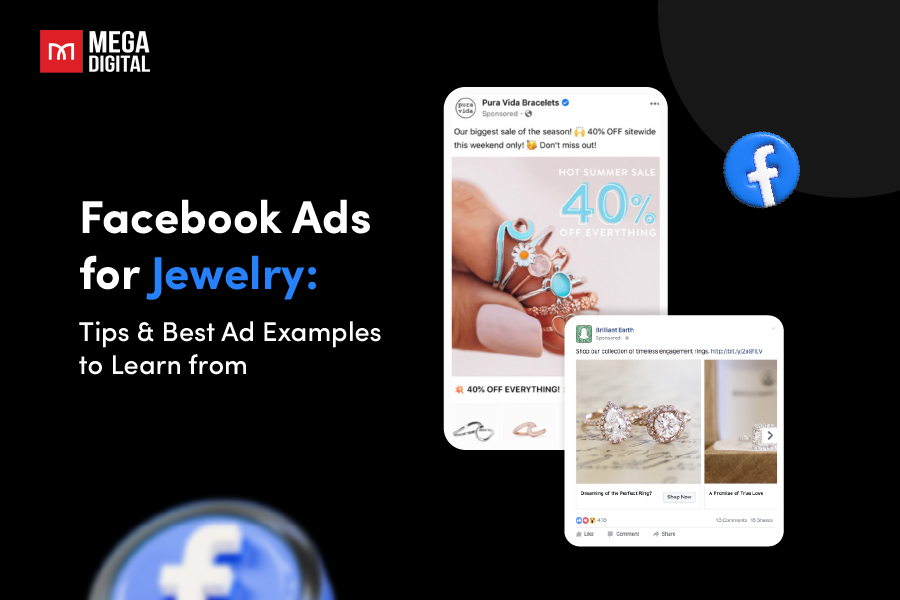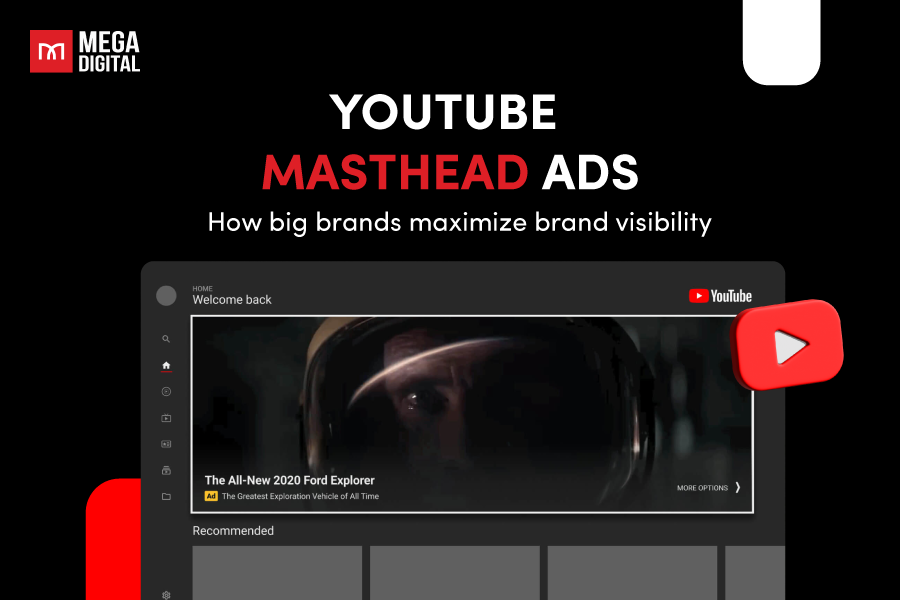YouTube Ads vs Facebook Ads, which is better? Although I want to give you a short answer, it’s hard to tell as they both offer different pros and cons. You may find your most compatible option, one that aligns with your business’s specific needs through this guide.
I’ll bring you an in-depth comparison between YouTube vs Facebook Ads that you’ll find nowhere else, so stay tuned!
Introduction of YouTube Ads vs Facebook Ads
YouTube Ads
As YouTube is the second-largest search engine globally with approximately 2.7 billion users monthly, it’s safe to say that YouTube Ads stand at the forefront of visual content for advertisers.
This platform helps reach a vast and diverse audience who keep watching videos as their daily activities. A plus thing is that most people already have a purpose when they search for something on YouTube.
As a subsidiary of Google, YouTube Ads seamlessly integrates with the Google Ads platform. This integration not only streamlines campaign management but also opens the door to robust targeting options, ensuring your ads reach the right audience at the right time.
You’ll also be utilizing the Google Ads network for your YouTube ads. There are 6 ad formats available on YouTube, which you might have encountered before:
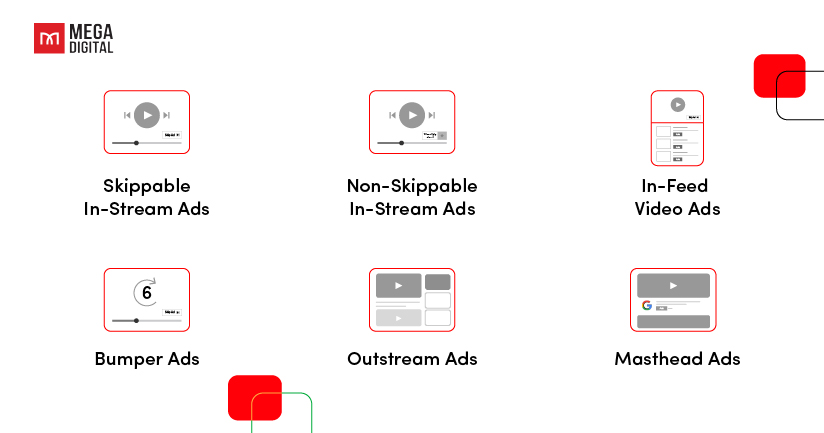
- Skippable In-stream Ads
- Non-skippable In-stream Ads
- In-feed Video Ads
- Bumper Ads
- Outstream Ads
- Masthead Ads
Advertisers can tailor their approach to align with specific objectives. You can explore each type in detail by referring to our other comprehensive guide available.
>>> Read more: YouTube Ads Types for Beginners: Comprehensive Guide in 2024
Facebook Ads
Facebook has over 3 billion active users, making it a very powerful platform for advertising. Many people choose to scroll on Facebook newsfeeds on a regular basis; however, most often look through the feed without specific intent or just seek content they prefer.
When you create a Facebook ad, it can appear alongside the organic posts that the users often interact with. These ads can also be displayed through both Facebook and Instagram, which are all programmed through the Meta Business Suite.
There are various Facebook ad types for you to choose from, depending on your advertising objective. This can also affect your ads’ placements in further platforms of the Metaverse.
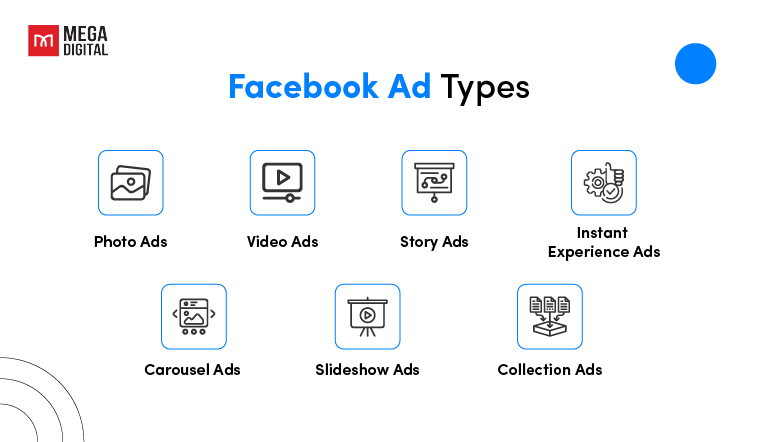
- Photo Ads: Single-image layout ideal for various goals, mimicking regular Facebook posts but flagged as sponsored.
- Video Ads: Engaging storytelling through videos, high engagement but time-consuming to create.
- Story Ads: Full-screen, immersive experiences in Facebook, Instagram, or Messenger Stories, offering creative freedom.
- Instant Experience Ads: Mobile-exclusive interactive ads providing dynamic engagement and faster loading times.
- Carousel Ads: Showcases multiple images or videos with individual links for versatile storytelling.
- Slideshow Ads: Uses motion, sound, and text for storytelling, suitable for areas with limited internet connections.
- Collection Ads: Mobile window-shopping experience with scrollable product lineups, perfect for large online stores.
Detail Comparison between YouTube Ads and Facebook Ads
Let’s break down the main differences and similarities between YouTube Ads and Facebook Ads, helping you make informed decisions based on your goals and budget.
Similarities of YouTube Ads vs Facebook Ads
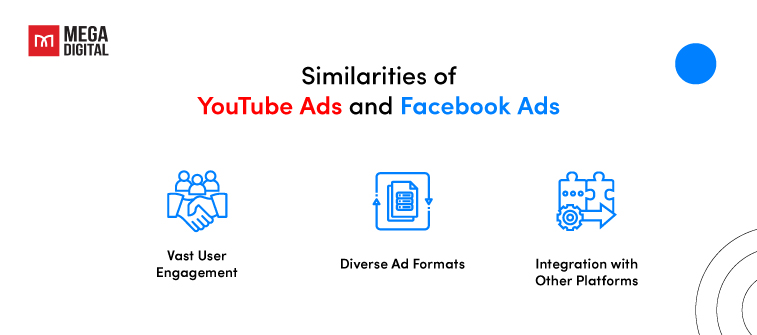
Vast User Engagement
Both YouTube and Facebook create unparalleled opportunities for advertisers to connect with their audiences.
YouTube, revered as the second-largest search engine globally, entices users with compelling visual storytelling.
Meanwhile, Facebook’s expansive social network encourages meaningful interactions and content sharing. Marketers can leverage this high engagement to build brand awareness and foster deeper relationships with their audience across both platforms.
Diverse Ad Formats
Both platforms offer a rich spectrum of ad formats to cater to varied campaign objectives. This diversity empowers advertisers to experiment with different creative approaches, tailoring content to captivate audiences and prompt specific actions.
YouTube primarily focuses on video content, supporting various video ad formats. As for its competitor, Facebook Ads supports a range of content types, including text, image, and video ads.
Integration with Other Platforms
Seamless integration with other digital marketing tools is a shared trait between YouTube Ads and Facebook Ads. YouTube, being an integral part of the Google ecosystem, integrates seamlessly with Google Ads, allowing for cohesive campaign management.
Similarly, Facebook Ads’ integration with Metaverse enhances tracking and retargeting capabilities, offering marketers a comprehensive view of user interactions across other platforms like Messenger or Instagram, which is potent for advertising, especially for visually striking products.
Differences between Facebook Ads vs YouTube Ads
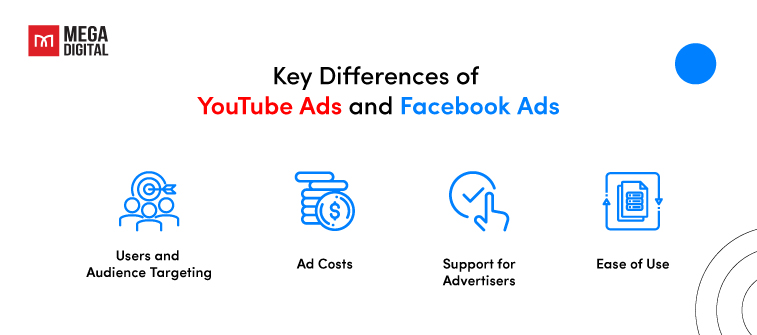
#1: Users and Audience Targeting
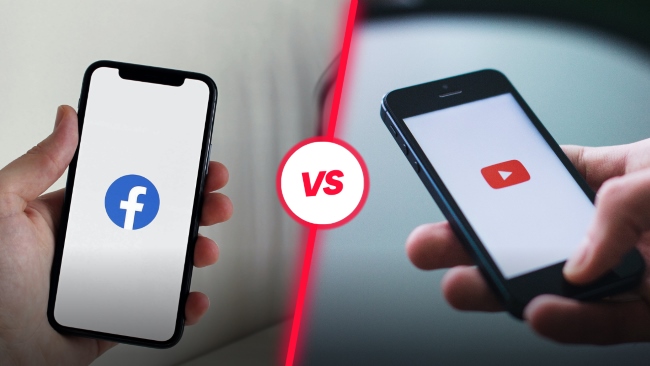
YouTube Ads Users and Audience Targeting
With Youtube targeting options, you can use keywords, target channels, and target specific videos. Then they have their own custom audience lists that you can go through based on life events and behavior, allowing advertisers to delve into demographics, interests, and content targeting.
YouTube has a big advantage with the real-time data from Google’s tracking. This allows advertisers to reach users actively searching for specific products or services, at the right time. Therefore, it is more suited for approaching B2B audiences.
For engagement methods, users on YouTube are often more prepared to watch videos, especially with sound on. The platform supports unskippable ads, encouraging users to engage with the content.
Note: If you’re offering a solution to something, consider YouTube ads as you can target “How To” keywords, so if someone is actively looking for how to solve a problem, you can put your ads up in front of those videos.
Facebook Ads Users and Audience Targeting
The sad truth is, over the past 3 years, Facebook ad targeting has offered fewer and fewer options, and relies on its algorithm to find the right audience.
Despite fewer detailed options, the algorithmic approach can still effectively match ads with users based on their interests and behaviors. Facebook Ads divide targeting into Core Audience, Custom Audience, and Lookalike Audience.
It is Ideal for B2C audiences as Facebook Ads help introduce products/services to audiences unfamiliar with the brand. The tricky part is that you’re not sure if they are interested in your products.
Facebook is also recognized for its ability to rapidly build email lists and effectively target users, ushering them into sales funnels and websites for profitable conversions.
#2: Ad Costs
Both platforms have quite identical costs. However, in recent times, YouTube may have lower costs over time due to a perceived lower level of competition compared to Facebook.

YouTube Ads Cost
Generally, YouTube ads cost $0.03 – $0.03 per view or click, measured through CPM (cost per thousand impressions). Businesses mostly pay a CPM ranging from $4 to $10, resulting in an average cost of $400 – $1000 for 100,000 views.
It can be challenging to specify costs precisely, as counts of impressions, views, and clicks vary. Some take 10 seconds, some 30, some are counted once people click on your thumbnail.
On average, running ads over time on YouTube may reveal lower costs due to a lower barrier to entry, as the platform generally faces less competition than Facebook in ad placement.
Facebook Ads Cost
In 2024, the typical expenses for Facebook ads are estimated to range from $0.26 – $0.30 per click, $1.01 – $3.00 per 1000 impressions, $0.00 – $0.25 per like, and $0.00 – $5.00 per download.
Facebook has reached a saturation point, leading to a highly competitive ad space where advertisers bid aggressively for limited visibility. The platform’s popularity has resulted in rising advertising costs, which are predicted to continue to increase.
Note:
- Costs are highly dependent on your niche or industry, with niche markets experiencing less competition and lower charges.
- They all have fancy automated bidding strategies.
#3: Support for Advertisers
When you plan to run ads on these platforms, it’s also crucial to know whether their teams can be helpful and supportive when you encounter problems. Well, in this case, these platforms are quite distinct.
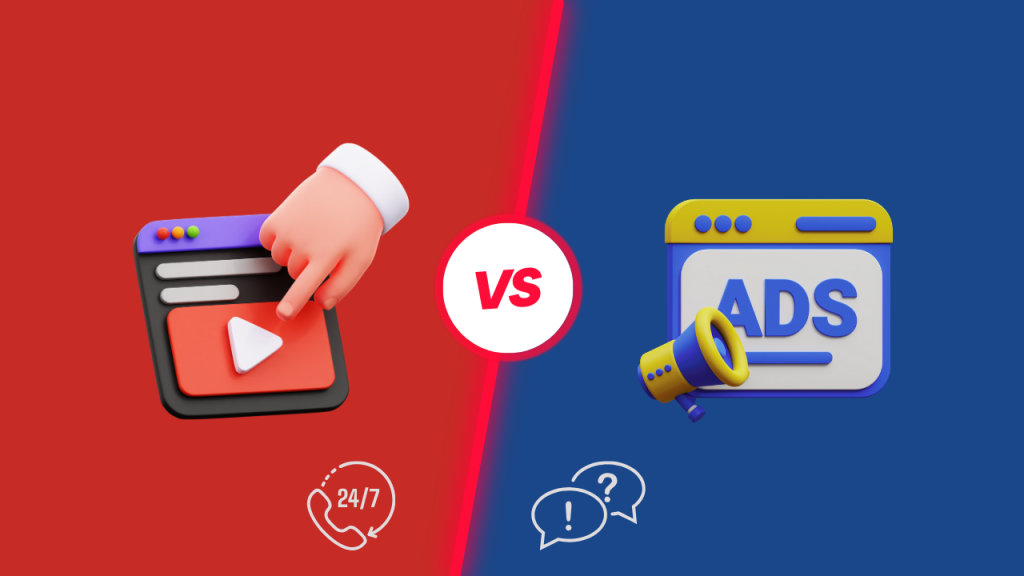
YouTube Ads Support for Advertisers
After years of experience with running YouTube Ads, it’s safe for us to say that YouTube has a great support environment. Many advertisers report that they rarely have issues with account shutdown. Even if they encounter such problems, YouTube offers fast support, providing strategic feedback on ad disapprovals and actively helping advertisers to get their ads approved.
Facebook Ads Support for Advertisers
On the other hand, the case of Facebook Ads is sadly, quite the opposite. The critical issue with Facebook is its strict approval process, which can lead to ad disapprovals, ad account shutdowns, business manager closures, and even personal bans.
The platform’s focus on larger advertisers makes it less friendly and supportive toward small businesses. The lack of responsiveness exacerbates these approval issues, creating frustration for advertisers.
Many people have complained that Facebook kicked them off the platform and disabled their accounts without support. So the state of Facebook right now is if you are able to run an ad on the platform, it’s still a decent advertising platform. If you encounter ad disapproval, you might be the unlucky ones.
But don’t worry! Read our guide here on how to fix it.
#4: Ease of Use
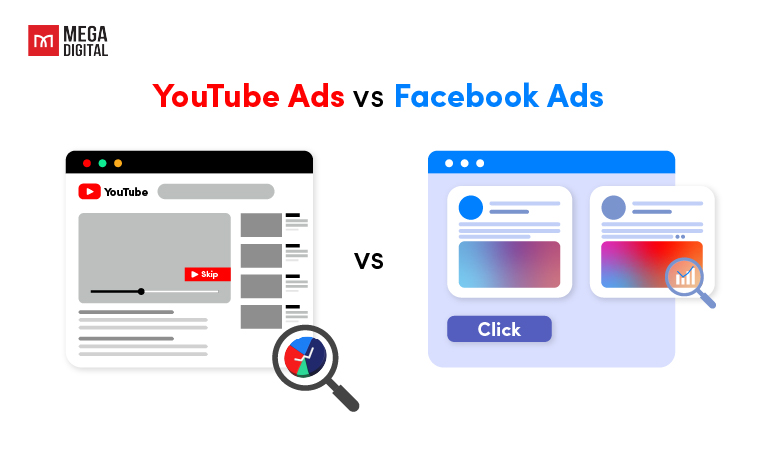
Both YouTube and Facebook present distinctive experiences in terms of convenience, account setup, and management. While generating content is essential, ensuring a seamless and comfortable adventure in the ad creation process is just as important.
| Aspect | YouTube | |
|---|---|---|
| Interface | Less user-friendly for beginners due to its intricate ad setup. | User-friendly, especially for novices, with a streamlined interface. |
| Account Setup | Requires creating a Facebook page, a bit more involved but necessary. Create Ad Sets, allowing for easier organization with the ability to write different contents inside one campaign. | Requires creating a Facebook page, a bit more involved but necessary. Create Ad Sets, allowing for easier organization with the ability to write different contents inside one campaign. |
| Management | YouTube only allows you to set a budget at the campaign level. | Facebook is easier with budget control at the Ad Set level. |
| Ad Creation Time | Time-consuming including scripting, graphic creation, recording, editing, and adding captions. | Faster ad creation with text and images, appealing for quicker turnaround. |
| Ad Approval Process | More lenient with better support for ad approval issues. | Strict ad approval policies, frequent disapprovals, and limited guidance. |
The most notable factor we can all agree on is that crafting video ads for YouTube demands significant time investment, potentially a drawback for businesses with limited resources or tight timelines, compared to Facebook ads which might be simpler and easier to make.
YouTube vs Facebook Ads: Which one you should choose for your campaigns
We’ve been in the trenches to decide which advertising platform suits best with our clients’ different campaigns. After years of experience with running ads on both platforms, we’ve somewhat figured out how these platforms function and which ads thrive in various scenarios.
Our suggestions come from this practical know-how rather than theories, offering insights you can rely on to make informed choices for your campaigns.
When to use YouTube Ads
- If your campaign relies heavily on video content to convey your message, YouTube’s video-focused platform is ideal.
- YouTube caters well to longer videos, making it suitable for in-depth storytelling or detailed demonstrations.
- If your goal is to reach audiences deeply engaged in specific content categories, YouTube’s targeting capabilities excel in this aspect.
When to use Facebook Ads
- Facebook offers a wide array of ad formats, making it adaptable for different content types, including images, videos, slideshows, etc.
- Facebook-owned platforms, including Instagram, are a strategic part of your campaign.
- If building a community or fostering engagement through comments, likes, and shares is vital, Facebook’s social nature is advantageous.
- Visually-driven niches such as fashion, are proven highly effective in Instagram integration.
Conclusion
The choice between Facebook Ads vs YouTube Ads isn’t just about the platforms; it’s about finding the perfect harmony for your unique business needs. Through tried and tested experiences, we’ve witnessed the unique strengths and weaknesses of each platform to tell you in this ultimate comparison.
So, YouTube Ads vs Facebook Ads, which one is your choice? Hopefully, our guide is helpful for you to make an informed decision. Don’t forget to subscribe to Mega Digital for more interesting advertising insights.







